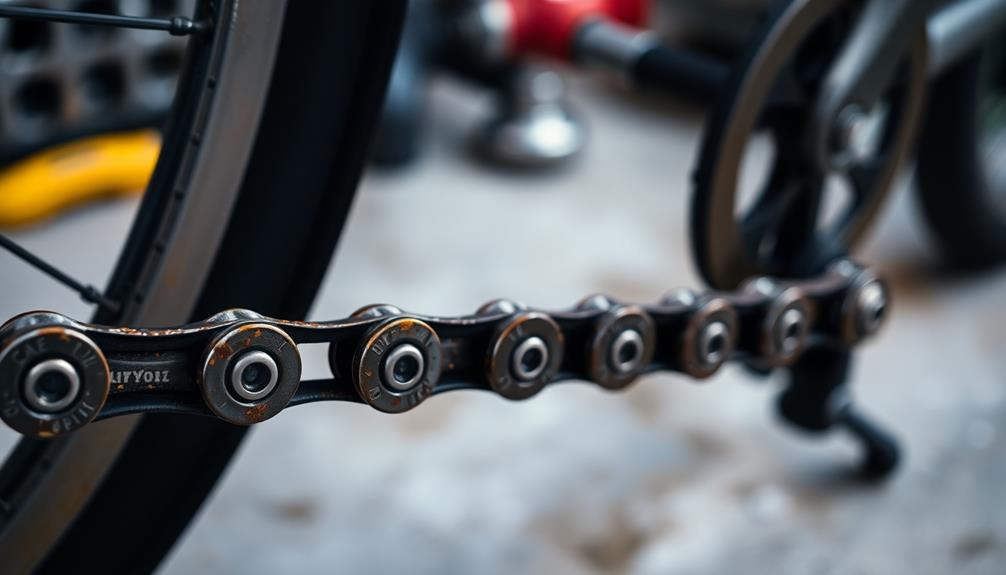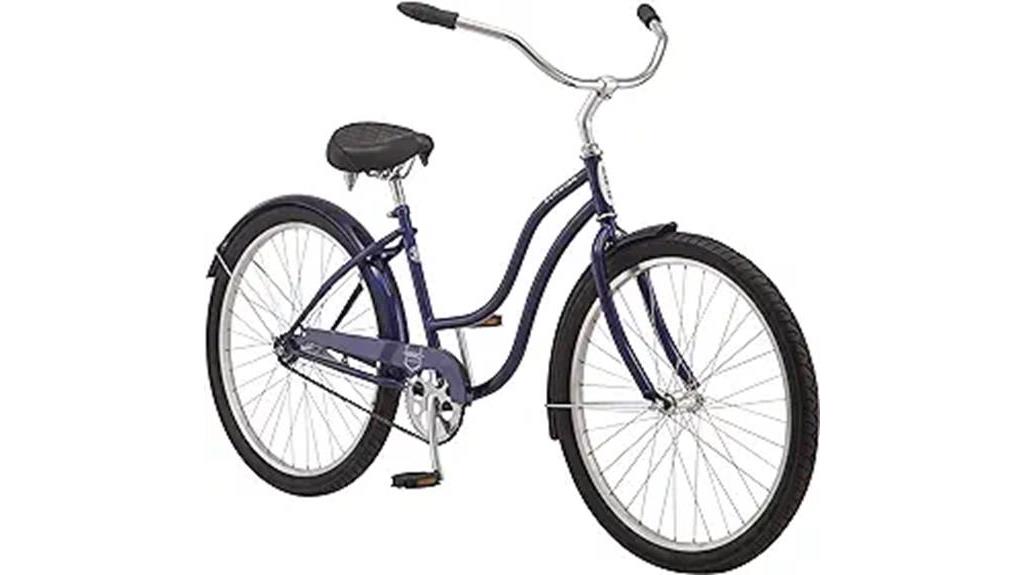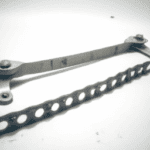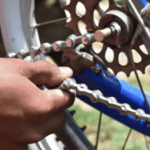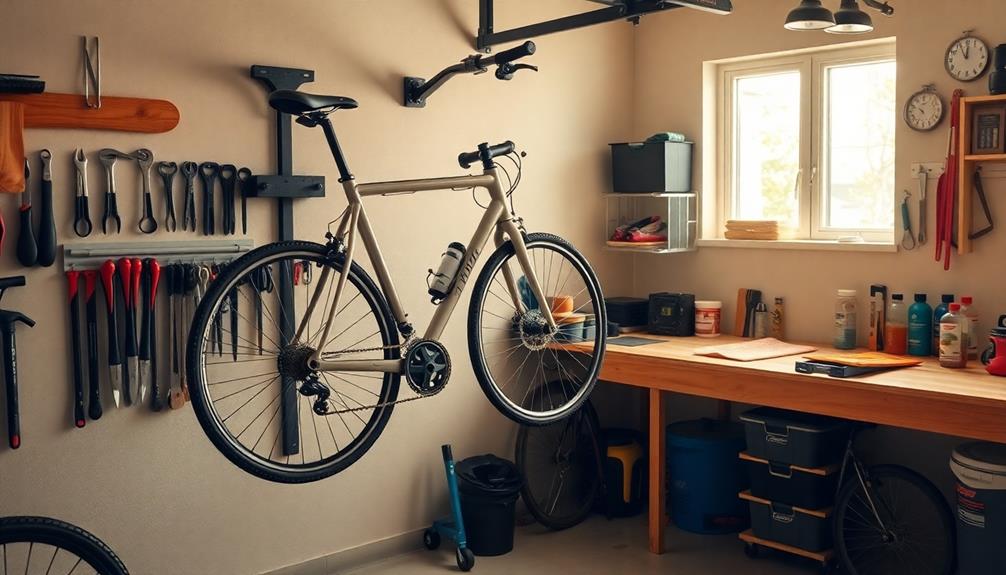You should replace your hybrid bike's chain as soon as it shows signs of wear. Regularly check for elongation; replace it when it reaches 0.5% wear, which is around 12 1/8 inches across 12 links. You'll want to measure your chain every 750 to 1,500 miles, depending on your riding conditions. Look out for symptoms like chain slipping or poor shifting, as these indicate it's time for a new chain. Keeping an eye on wear prevents damage to other components. If you're curious about the best methods and tools for checking, there's a lot more to explore.
Key Takeaways
- Replace the chain when it measures 12 1/8 inches or shows 0.5% elongation to prevent drivetrain damage.
- Regularly check the chain every 750 to 1,500 miles, depending on riding conditions and style.
- Use a CC-4 chain checker or ruler to accurately measure chain wear and ensure optimal performance.
- Symptoms like chain slipping or poor shifting indicate the need for immediate replacement.
- Clean the chain every 100 miles to prevent grit buildup and extend its lifespan.
Understanding Chain Components
Understanding the key components of your hybrid bike's chain is fundamental for maintaining its performance. A modern chain consists of several essential components, including pins (or rivets), outer links, inner links, bushings, and rollers. Each part works in harmony to guarantee efficient operation while you ride.
The standard pitch for multi-speed bike chains, including those on hybrid bicycles, is 0.5 inches (12.7 mm) between pins, which is crucial for compatibility with your bike's derailleurs and cassette systems. Additionally, much like the role of color accuracy in home cinema projectors, the precision of these chain components greatly affects your riding experience.
The chain links alternate between outer and inner plates, creating segments that facilitate smooth shifting and effective power transfer. However, as you ride, these components can wear down. Over time, worn bushings can lead to an increased inner diameter, which causes pin grooving and ultimately affects your chain's performance and longevity.
To guarantee your chain remains in ideal condition, regular maintenance is key. You can measure wear using a chain checker, like the CC-4, which assesses wear at important intervals of 0.5% and 0.75%. Knowing when to replace your chain will help you keep your hybrid bike running smoothly and efficiently.
Measuring Chain Wear

To keep your hybrid bike running smoothly, measuring chain wear is vital for guaranteeing peak performance. Regular maintenance not only enhances your riding experience but also protects your overall investment in cycling equipment.
Start by using a ruler to measure your chain: align a rivet at the zero mark and count 24 rivets. If the last rivet exceeds 12 inches, you've got a worn chain that's ready for replacement. A chain that measures 12 1/16 inches indicates 0.5% elongation, which is your cue to replace the chain.
For an even more accurate measurement, consider using a CC-4 chain checker tool. This handy chain wear indicator measures wear at three contact points and tells you exactly when to think about chain replacement, particularly at the 0.5% and 0.75% elongation marks.
It's essential to perform regular checks on multiple sections of the chain since wear can be uneven. If you're a high-mileage cyclist or often ride in harsh conditions, increase the frequency of these measurements to prevent premature wear and severe drivetrain damage.
Keeping an eye on your chain's condition helps maintain your bike's performance and prolongs its lifespan. Additionally, just as in creating a personal budget, monitoring your chain guarantees you avoid unexpected costs associated with bike repairs.
Importance of Regular Checks
Regular checks of your hybrid bike's chain can considerably enhance your riding experience and save you money in the long run. When you monitor chain wear, you're not just guaranteeing a smooth ride; you're also preventing poor shifting and potential chain breakage. A worn chain can elongate by as much as 1%, leading to issues that extend beyond just the chain itself.
For example, if you're aware of how to maintain your bike's components effectively, you can also prevent other maintenance issues, much like using essential oils for toothache relief to avoid further dental problems. If you neglect to replace your chain when it reaches 0.5% wear, you risk damaging more expensive components like the cassette and chainring.
Investing in preventative maintenance by checking your chain regularly can save you from hefty repair costs down the line. The drivetrain is a complex system, and a worn chain can lead to premature wear on other parts, shortening their lifespan.
For high-mileage cyclists, increasing the frequency of these checks is crucial. By being proactive and monitoring chain wear, you guarantee that your bike performs at its best. Ultimately, regular checks not only enhance your riding experience but also protect your investment by reducing the likelihood of costly repairs.
Replacement Timing Guidelines

Knowing when to replace your hybrid bike's chain is vital for maintaining peak performance and safety.
Regular chain replacements can prevent damage to other bike components and improve your overall riding experience. Additionally, just as with cold medications, selecting the right time for maintenance is critical for best performance.
Here are some guidelines to help you determine when it's time for a new chain:
1. Measure for wear: Check your chain with a chain checker tool. If it reaches a wear limit of 0.5% elongation (12 1/8 inches across 12 links), it's time to replace it.
2. Mileage matters: Aim to check and possibly replace your chain every 750 to 1,500 miles, depending on the riding conditions and how well you're cleaning and lubing it.
Consider potential side effects of neglecting maintenance to avoid further issues.
3. Watch for symptoms: If you experience symptoms such as chain slipping or poor shifting performance, your chain should be replaced sooner.
Methods for Checking Wear
Three effective methods can help you check your hybrid bike's chain wear and determine if it needs replacement.
First, use a ruler to measure 12 inches across 12 links of your chain. If the last rivet goes beyond the 12-inch mark, your chain is worn and may need replacement. Regular maintenance, much like how wood-burning stoves require upkeep for peak performance, is essential for guaranteeing your bike functions smoothly.
Next, consider using a chain checker tool, like the CC-4, which provides wear readings at 0.5% and 0.75% elongation. This tool can help you accurately determine when your chain should be replaced based on specific wear guidelines.
Lastly, perform a visual inspection by lifting the chain off the chainring. If you see significant daylight between the chain and the chainring, your chain is nearing its replacement threshold.
Always guarantee the chain is properly tensioned during these wear measurements, as incorrect tension can affect the accuracy of your readings.
Regular checks are vital, with a replacement interval suggested at 0.5% elongation for 11-speed chains and 0.75% for 6-10 speed chains. By staying proactive, you can maintain peak performance and extend the life of your hybrid bike.
Tools for Accurate Measurement

To accurately measure your bike chain's wear, you'll need the right tools. Chain checkers like the SBC-1 and CC-4 provide precise readings, while a simple ruler can also do the trick.
Ensuring your bike's performance can be compared to maintaining clean air in your home; just as an air purifier improves indoor air quality, a well-maintained chain enhances your ride.
Just remember to measure the chain under tension for the best results.
Essential Measurement Tools
When it comes to measuring your hybrid bike's chain wear, having the right tools at your disposal makes all the difference. Accurate measurement is vital to guarantee your bike runs smoothly and to determine when to replace your chain.
Proper chain maintenance can also enhance the longevity of your bike, similar to how butter enhances flavor and texture in cooking. Here are three essential measurement tools you should consider:
- SBC-1 Chain Checker: This tool is designed for precise wear measurements and can help you catch wear before it becomes an issue.
- CC-4 Chain Checker: Perfect for 5-to-12 speed chains, this tool checks wear at three points and indicates wear levels at 0.5% and 0.75%.
- Ruler Method: If you prefer a DIY approach, align a rivet at the zero mark and count 24 rivets to check if the last rivet reaches the 12-inch mark, signifying a new chain.
Always guarantee you clean your chain before measuring; dirt and grime can skew your results.
Proper Measurement Techniques
Accurate measurement techniques are key to evaluating your hybrid bike's chain condition effectively. To get reliable results, use a chain checker like the CC-4, which measures wear at 0.5% and 0.75% intervals. This tool allows you to measure wear quickly and make accurate assessments of whether it's time to replace your chain.
Additionally, just as you'd evaluate the performance of a robot vacuum before purchasing, understanding your bike's chain condition is essential for guaranteeing a smooth ride.
Before you measure, always clean the chain thoroughly. Dirt and grime can skew your measurement results, leading to inaccurate conclusions about your chain's condition.
When measuring with a ruler, align a rivet at the zero mark and confirm the final rivet reaches exactly the 12" mark. Any deviation over 1/16" indicates wear.
It's also wise to check multiple sections of the chain to account for uneven wear. Chains can stretch inconsistently, so measuring different areas helps you get a complete picture.
Finally, maintain proper tension on the chain while measuring. Variations in tension can result in misleading readings that may cause you to underestimate wear.
Cost Considerations for Replacement

Replacing your hybrid bike's chain can be a straightforward expense, typically falling between $20 and $50 depending on brand and specifications. While this may seem minimal, neglecting chain wear can lead to greater expenses down the road. By investing in quality replacement chains and monitoring with a chain wear indicator, you can greatly reduce your overall maintenance costs.
Regular maintenance guarantees peak functioning of components and enhances your bike's performance, making it easier to enjoy commuting efficiency and fitness benefits.
Consider these cost factors:
- Cassettes and Chainrings: Replacing your cassette can set you back anywhere from $20 to $150. A well-maintained chain can extend the life of these components by 3-5 times, saving you money.
- Chain Wear Indicator: Spending $10 to $30 on a chain wear indicator tool can help you prevent premature wear by tracking elongation accurately.
- Drivetrain Systems: Different drivetrain systems have varying replacement costs. Being aware of these can help you budget effectively and avoid unexpected expenses.
Ultimately, replacing your chain every 0.5% to 1% elongation will save you from costly repairs and keep your bike running smoothly.
Don't ignore chain wear; it's key to maintaining your bike's performance and longevity.
Impact of Maintenance Practices

Effective maintenance practices can greatly influence the lifespan and performance of your hybrid bike's chain. Regular cleaning the chain every 100 miles or after bad weather can markedly prolong its lifespan by preventing grit accumulation and reducing wear.
Additionally, understanding the benefits of proper merchant account credit processing can help business owners manage their finances better, allowing them to invest in quality bike maintenance tools. You should use a scrub brush and solvent or an ultrasonic cleaner to remove internal grime, which is vital for maintaining ideal chain performance.
After cleaning, allow the chain to dry completely, as moisture can lead to rust and degrade the components faster. Proactive maintenance routines, including regular inspections based on mileage, help you spot wear before it becomes paramount. If you notice signs of wear, you'll know it's time to replace a chain before it damages other parts.
Tailoring your maintenance practices to specific riding conditions is also essential. For example, if you frequently ride in dusty or wet environments, you might need to clean the chain more often to enhance its longevity and performance.
Riding Style and Chain Longevity
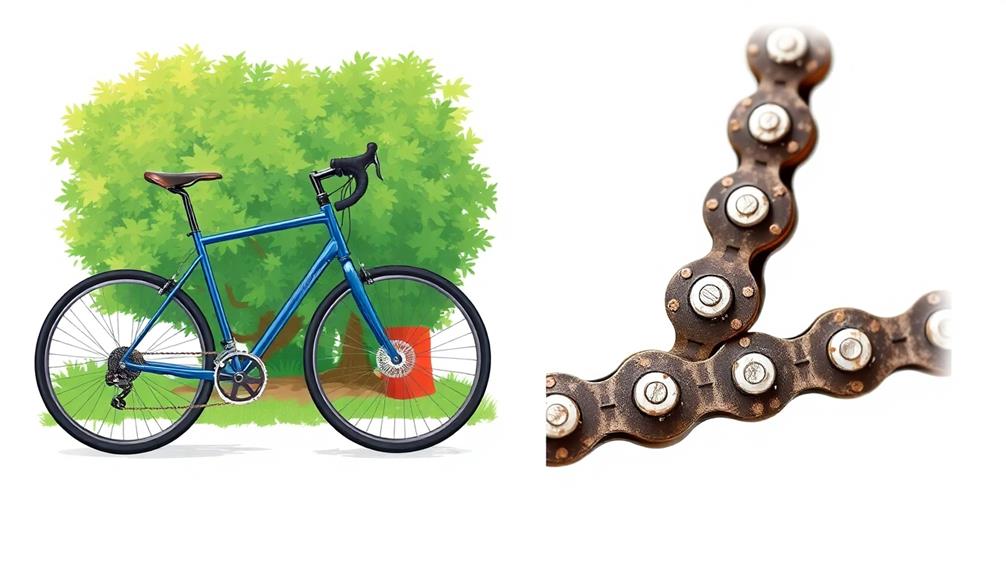
Your riding style plays an important role in determining how long your hybrid bike's chain will last. If you ride aggressively or tackle steep hills, your chain faces increased wear rates, leading to a shorter chain lifespan.
Here are three key factors to take into account:
- Power Exertion: The more force you apply, the faster your chain wears.
- Gear Shifting: Frequent shifts can cause additional strain, necessitating more regular inspections and replacements.
- Riding Conditions: Gravel or hilly terrain increases wear, so expect to replace your chain more often than on flat, paved surfaces.
Proper maintenance, including cleanliness and lubrication, directly impacts chain longevity. By incorporating a regular cleaning routine, you can greatly extend your chain's life.
Neglecting maintenance may lead to performance issues that could have been avoided.
Ultimately, your riding habits dictate how often you should check or replace your chain. Some riders prefer to replace their chains preemptively for peace of mind, while others may wait until they notice considerable wear.
Understanding your riding style is essential for maximizing your hybrid bike's chain lifespan.
Frequently Asked Questions
How Long Does a Hybrid Bike Chain Last?
A hybrid bike chain typically lasts between 750 to 1,500 miles, but with regular maintenance, you might stretch it to 4,000 to 6,000 miles. Riding conditions and style impact its longevity, so stay attentive!
How Do I Tell if My Bike Chain Needs Replacing?
Ever felt your bike struggle while you ride? To tell if your chain needs replacing, use a chain checker, visually inspect for daylight, and watch for slipping or difficulty shifting. Regular checks keep your ride smooth!
How Often Should You Change an E-Bike Chain?
You should change your e-bike chain every 750 to 1,500 miles, depending on your riding conditions. Regularly check for elongation using a wear indicator tool to guarantee peak performance and prevent damage to your cassette.
What Is the Lifespan of a Bike Chain?
Bike chains bring boundless benefits, but their lifespan varies. Generally, you'll find chains last between 750 and 1,500 miles. With proper care, you might stretch that to 4,000-6,000 miles. Keep riding and maintain!
Conclusion
To summarize, keeping an eye on your hybrid bike's chain can save you time and money in the long run. Did you know that a worn chain can lead to up to 40% more wear on your bike's drivetrain components? By regularly checking for wear and knowing when to replace it, you can guarantee a smoother ride and extend the life of your bike. Stay proactive, and your bike will thank you with many more enjoyable rides ahead!
